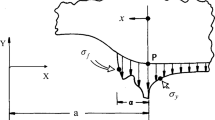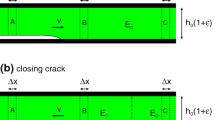Abstract
The assumption of a material specific relation between the energy dissipation at the edge of a crack propagating under small scale yielding conditions leads to upper limits of the crack velocity: the Rayleigh wave velocity for modes I and II, and theS wave velocity for mode III. If a mode II crack can pass the “forbidden” subsonic super-Rayleigh region, then the upper limit would be theP wave velocity. Experiments invariably show lower maximum speeds, typically less than 60% of theS wave velocity, but they also frequently show accelerations to a constant velocity, depending on the acceleration history, and increasing surface roughness, even during the constant velocity phase. Other experiments show that the energy dissipation at the crack edge usually is several times larger at very high than at very low velocities. These results indicate a considerable growth of the process region, so much that the intrinsic length parameter which determines its height at very low crack speeds becomes insignificant, and then the rationale for a material specific relation between energy dissipation and velocity disappears. This disappearance can contribute to the explanation of the experimental results.
Similar content being viewed by others
References
H. Schardin, “Ergebnisse der kinematographischen Untersuchung des Glasbruchvorganges”,Glastechnische Berichte,23, 1–10, 67–69, 325–336 (1950).
H. Schardin, “Velocity effects in fracture”, in: B. L. Averbach, D. K. Felbeck, G. T. Hahn, and D. A. Thomas (editors),Fracture, John Wiley & Sons, New York (1959), pp. 297–329.
K. B. Broberg, “On the speed of a brittle crack”,J. Appl. Mech.,31, 546–547 (1964).
K. B. Broberg, “Discussion of fracture from the energy point of view”, in: B. Broberg, J. Hult, and F. Niordson (editors),Recent Progress in Applied Mechanics, Almquist and Wiksell, Stockholm (1967), pp. 125–151.
K. B. Broberg, “Intersonic bilateral slip”,Geophys. J. International,119, 706–714 (1994).
G. I. Barenblatt, “The formation of equilibrium cracks during brittle fracture. General ideas and hypotheses. Axially-symmetric cracks”,Prikl. Mekh. Mater.,23, 434–444 (1959);English translation: J. Appl. Mech,23, 622–636 (1959).
M. Ya. Leonov and V. V. Panasyuk, “Development of the smallest cracks in a solid body”,Prikl. Mekh.,5, 391–401 (1959).
V. V. Panasyuk, “To the theory of crack propagation in deformed brittle body”Dopov. Akad. Nauk Ukr. SSR,9, 1185–1188 (1960).
D. S. Dugdale, “Yielding of steel sheets containing slits”,J. Mech. Phys. Solids,8, 100–104 (1960).
R. J. Archuleta, “Analysis of near source static and dynamic measurements from the 1979 Imperial Valley earthquake,”Bull. Seismolog. Soc. Amer.,72, 1927–1956 (1982).
C. H. Scholtz,The Mechanics of Earthquakes and Faulting, Cambridge University Press, Cambridge.
K. B. Broberg, “On dynamic crack propagation in elastic-plastic media”, in: G. C. Sih (editor),Proceedings of the International Conference on Dynamic Crack Propagation, Noordhoff International Publishing, Leyden (1973), pp. 461–499.
T. L. Paxson and R. A. Lucas, “An experimental investigation of the velocity characteristics of a fixed boundary fracture model”, in: G. C. Sih (editor),Proceedings of the International Conference on Dynamic Crack Propagation, Noordhoff International Publishing, Leyden (1973), pp. 415–426.
K. B. Broberg, “On the behaviour of the process region at a fast running crack tip”, in: K. Kawata and J. Shioiri (editors),High Velocity Deformation of Solids, Springer-Verlag, Berlin-Heidelberg (1979), pp. 182–194.
K. B. Broberg, “Twilight zone of fracture”, in: V. V. Panasyuk, D. M. R. Taplin, M. C. Pandey, O. Ye. Andreykiv, R. O. Ritchie, J. F. Knott, and P. Rama Rao (editors),Advances in Fracture Resistance and Structural Integrity, Pergamon, Oxford (1994). pp. 59–66.
J. F. Kalthoff, “On some current problems in experimental fracture mechanics”, in:Workshop on Dynamic Fracture, California Institute of Technology, Pasadena (1983), pp. 11–35.
K. Ravi-Chandar,An Experimental Investigation into the Mechanics of Dynamic Fracture, Ph. D. Thesis, California Institute of Technology, Pasadena (1982).
K. Ravi-Chandar and W. G. Knauss, “An experimental investigation into dynamic fracture: I. Crack initiation and arrest”,Int. J. Fract.,25, 247–262 (1984); “II. Microstructural aspects”,Int. J. Fract.,26, 65–80 (1984); “III. On steady-state crack propagation and crack branching”,Int. J. Fract.,26, 141–154 (1984); “IV. On the interaction of stress waves with propagating cracks”,Int. J. Fract.,26, 189–200 (1984).
K. Takahashi and K. Arakawa, “Dependence of crack acceleration on the dynamic stress-intensity factor in polymers”Experim. Mech.,27, 195–200 (1987).
K. Arakawa and K. Takahashi, “Relationship between fracture parameters and fracture surface roughness of brittle polymers”,Int. J. Fract.,48, 103–114 (1991).
L. B. Freund, “Some theoretical results on the dependence of the dynamic stress intensity factor on crack tip speed”, in:Workshop on Dynamic Fracture, California Institute of Technology, Pasadena (1983), pp. 129–136.
J. W. Dally, W. L. Fourney and G. R. Irwin, “On the uniqueness of the stress intensity factor-crack velocity relationship”,Int. J. Fract.,27, 159–168 (1985).
W. Yang and L. B. Freund, “Transverse shear effects for through-cracks in an elastic plate”,Int. J. Solids Struct.,21, 977–994 (1985).
A. J. Rosakis and K. Ravi-Chandar, “On crack-tip stress state: an experimental evaluation of three-dimensional effects”,Int. J. Solids Struct.,22, 121–134 (1986).
L. B. Freund and A. J. Rosakis, “The structure of the near-tip field during transient elastodynamic crack growth”,J. Mech. Phys. Solids,40, 699–719 (1992).
C. Liu, A. J. Rosakis and L. B. Freund, “The interpretation of optical caustics in the presence of dynamic non-uniform crack-tip motion histories: A study based on a higher order transient crack-tip expansion”,Int. J. Solids Struct.,30, 875–897 (1993).
H. Gao, “Surface roughening and branching instabilities in dynamic fracture”,J. Mech. Phys. Solids,41, 457–486 (1993).
L. I. Slepyan, “Principle of maximum energy dissipation rate in crack dynamics”,J. Mech. Phys. Solids,41, 1019–1033 (1993).
P. D. Washabaugh and W. G. Knauss, “A reconciliation of dynamic crack velocity and Rayleigh wave speed in isotropic brittle solids”,Int. J. Fract.,65, 97–114 (1994).
E. Johnson, “Process region changes for rapidly propagating cracks”,Int. J. Fract.,55, 47–63 (1992).
E. Johnson, “Process region influence on crack branching”,Int. J. Fract.,57, R27-R29 (1992).
E. Johnson, “Process region influence on energy release rate and crack tip velocity during rapid crack propagation”,Int. J. Fract.,61, 183–187 (1993).
Additional information
Department of Mathematical Physics, University College Dublin, Belfield, Dublin, Ireland. Published in Fizyko-Khimichna Mekhanika Materialiv, Vol. 32, No. 1, pp. 91–98, January–February, 1996.
Rights and permissions
About this article
Cite this article
Broberg, K.B. How fast can a crack go?. Mater Sci 32, 80–86 (1996). https://doi.org/10.1007/BF02538928
Received:
Issue Date:
DOI: https://doi.org/10.1007/BF02538928




